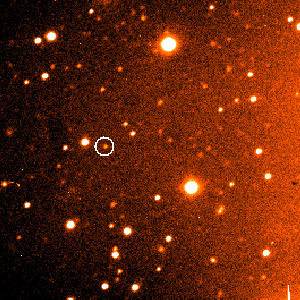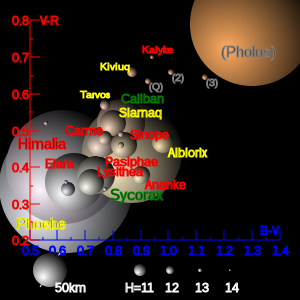Caliban (moon)
| Caliban | |
|---|---|

|
|
| Discovery picture from Caliban, 1997 | |
| Provisional or systematic name | S / 1997 U 1 |
| Central body | Uranus |
| Properties of the orbit | |
| Major semi-axis | 7,164,900 km |
| Periapsis | 6,599,100 km |
| Apoapsis | 7,730,700 km |
| eccentricity | 0.0789681 |
| Orbit inclination | 120.28 (equatorial plane) 139.88509 (ecliptic) ° |
| Orbital time | 579.39 d |
| Mean orbital velocity | 0.91 km / s |
| Physical Properties | |
| Albedo | ≈ 0.04-0.07 |
| Apparent brightness | 22.4 mag |
| Medium diameter | ≈ 72 km |
| Dimensions | ≈ 2.5-7.3 · 10 17 kg |
| surface | ≈ 16,300 km 2 |
| Medium density | ≈ 1.3-1.5 g / cm 3 |
| Sidereal rotation | 0.1125 days (2.7 hours) |
| Axis inclination | 98.732 ° |
| Acceleration of gravity on the surface | 0.038 m / s 2 |
| Escape speed | 52 m / s |
| Surface temperature | ≈ −184 to −208 ° C / 89–65 K |
| discovery | |
| Explorer |
Brett J. Gladman , |
| Date of discovery | September 6, 1997 |
| Remarks | Physical data relatively imprecise |

|
|
| Size comparison of irregular moons in the solar system, including Caliban | |
Caliban (also Uranus XVI ) is the twenty-first of the 27 known and the second of the outer retrograde irregular moons of the planet Uranus . It is the second largest of the planet's irregular natural satellites .
Discovery and naming
Caliban was in the night of 6 to 7 September 1997, a team consisting of the astronomer Philip D. Nicholson , Joseph A. Burns , and John J. Kavelaars on photographic images on the same night as the largest known irregular moon of Uranus Sycorax added . The images were taken through the 5.0 meter reflector telescope of the Hale Observatory in California ( USA ). The actual discovery was made by team member Brett J. Gladman in early October, who tracked down both moons on the images. Caliban and Sycorax were the first irregular moons on the planet to be discovered. The discovery was announced on April 30, 1998; the moon was initially given the provisional designation S / 1997 U 1 at the end of October 1997 .
In 1999, on the suggestion of Brett Gladman, Phil Nicholson, Joseph Burns, J. J. Kavelaars, Brian Geoffrey Marsden , Gareth V. Williams and Warren B. Offutt, the moon was officially named Caliban, like all irregular Uranus moons except Margaret after a figure in William Shakespeare's comedy The Tempest . The wild monster Caliban , son of the witch Sycorax , is the grotesque slave of the wise magician Prospero , who was imprisoned and also tortured by him on an island. Caliban is an anagram of canibal ( cannibals ).
So far, all Uranus moons have been named after characters from Shakespeare or Alexander Pope . The first four Uranus moons discovered ( Oberon , Titania , Ariel , Umbriel ) were named after suggestions by John Herschel , the son of the Uranus discoverer Wilhelm Herschel . Later the tradition of naming was retained.
The provisional designation S / 1997 U 1 corresponds to the system of the International Astronomical Union (IAU).
Track properties
Orbit
Caliban orbits Uranus on a retrograde , for an irregular moon, relatively slightly elliptical orbit between 6,599,100 and 7,730,700 km from its center ( major orbit half-axis 7,164,900 km or 280.329 Uranus radii), i.e. around 7,139,000 km above its cloud ceiling. The orbit eccentricity is 0.0789681, the orbit is 139.88509 ° inclined to the ecliptic . The inclination towards the equator of Uranus is 120.28 °. Caliban is about 12 times as far from Uranus as the outermost regular moon Oberon .
Due to the great distance to Uranus and gravitational disturbances from the sun and other factors, the orbit parameters are possibly variable; the moon could perhaps also enter a heliocentric orbit (again). The eccentricity is therefore also given between 0.1590 and 0.1812, the orbit inclination (with respect to the ecliptic) between 139.89 ° and 141.529 ° and the major orbit half-axis with 7.2311 million km. The orbit of Caliban is surprisingly circular for an irregular moon, the eccentricity is probably the lowest of all irregular Uranus moons .
Caliban is the largest and eponymous member of the Caliban group , a subgroup of irregular moons with moderate eccentricity and high orbital inclinations between 140 and 170 °, to which Francisco , Stephano and Trinculo also belong. However, Caliban is far more red in color than the other moons in the group, which are more gray in color.
The orbit of the next inner moon Francisco is on average about 4 million km from Caliban's orbit, the distance of the orbit of the next outer moon Stephano is on average about 800,000 km.
Caliban orbits Uranus in around 579 days, 9 hours and 22 minutes, or around 1,586 earth years. The orbital period is also given as 579.73 days. Caliban therefore needs longer to orbit Uranus than the earth around the sun.
rotation
The light curve of Caliban indicates a rotation of 2 hours and 42 minutes (2.7 h ) and a strongly inclined axis of rotation of 98.732 °, which means that the moon and its orbit would have a retrograde direction of rotation.
Physical Properties
Caliban has an estimated diameter of 72 km (according to other information 96-98 km), based on the assumed reflectivity of 4%, which can, however, also be 7%. In any case, the surface is extremely dark. Its density is estimated to be between 1.3 and 1.5 g / cm 3 . The moon is therefore likely to be composed mainly of water ice and silicate rock. On its surface, the acceleration due to gravity is 0.038 m / s 2 , which corresponds to just under 0.4% of that on earth.
surface
Almost nothing is known about the surface of Caliban. According to some reports, it has a reddish appearance, redder than Jupiter's moon Himalia , but less red than most Kuiper Belt objects. Caliban is possibly a little redder than the largest irregular Uranus moon Sycorax . It also absorbs light at a wavelength of 0.7 µm , and a group of astronomers believe this was due to water ice that renewed the surface of Caliban.
Emergence
Caliban is believed to be a trapped object of the Kuiper Belt and not originated in the accretion disk that formed the uranium system. It is conceivable that the moon first went from a Kuiper belt object to a centaur and was then captured by Uranus. The exact trapping mechanism is unknown, but trapping a moon requires dissipating energy. The hypotheses range from the entry of gas into the protoplanetary disk , interactions in the context of the multibody problem and capture by the rapidly increasing mass of Uranus. The orbital parameters indicate that Caliban belongs to the same dynamic group as Stephano and Francisco , and therefore these moons likely have a common origin.
exploration
Due to the great distance to Uranus and the weak brightness of 22.4 mag, which is 1: 5750000 compared to the central planet, Caliban was not found when the Voyager 2 space probe flew by in 1986. Since its discovery in 1997, Caliban could only be observed through earth-based telescopes and its orbital elements and its brightness could be determined.
Web links
- IAUC 6764: Satellites of Uranus October 31, 1997 (discovery)
- IAUC 6870: S / 1997 U 1 April 7, 1998 (rediscovery)
- IAUC 7132: Satellites of Uranus March 27, 1999 (numbering and naming)
- Polish moon page: Caliban description and further links (English)
- Discovery of two distant irregular moons of Uranus April 30, 1998 (discovery report )
- Update on New Satellites of Uranus February 2000 (proposed name)
Individual evidence
- ^ IAU: Natural Satellites Ephemeris Service. IAU Minor Planet Center, accessed February 11, 2011 .
- ^ M. Maris, G. Carraro, G. Cremonese, M. Fulle: Multicolor Photometry of the Uranus irregular satellites Sycorax and Caliban. Iopscience, accessed February 11, 2011 .
- ↑ Richard W. Schmude, jr .: Uranus, Neptune, Pluto and how to observe them. Springer, accessed February 12, 2011 .
